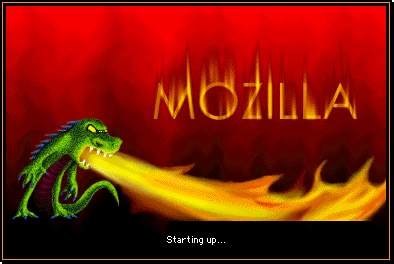 Today, we want to highlight that it was 10 years ago, on June 5 in 2002, that version 1.0 of the open source Mozilla web browser suite was released, blazing a path to the most recent Firefox.
Today, we want to highlight that it was 10 years ago, on June 5 in 2002, that version 1.0 of the open source Mozilla web browser suite was released, blazing a path to the most recent Firefox.
The simple significance of this is that without Mozilla 1.0, Firefox may never have existed.
That makes today an important day in the history of the Internet in general, and the web in particular. In what seems like a lucky coincidence, Firefox 13 is officially released today, something that is no doubt welcome news for scores of users.
First browser war was over – IE won
The story of Mozilla starts after Microsoft had won the first browser war in the 1990s, when Netscape released most of its browser suite as open source in March 1998.
Netscape called the move, in a press release, “bold” and “aggressive.”
Netscape’s President and CEO at the time, Jim Barksdale, said: “By giving away the source code for future versions, we can ignite the creative energies of the entire Net community and fuel unprecedented levels of innovation in the browser market.”
The Mozilla project was then formed and set out to create a new browser, which, they hoped, would be able to take back market share from Microsoft’s Internet Explorer.
More than four years in the making
Initial excitement over Netscape’s decision to set the source code free seemed to have turned into frustration because of having to deal with old code. The team working on Mozilla decided to throw out the old code and start over. Brendan Eich, creator of the JavaScript scripting language and the present CTO at the Mozilla Corporation wrote: “It’s time to stop banging our heads on the old layout and… codebase.”

Out of this came a lot of new developments, including what still beats at the heart of Firefox today, the Gecko layout engine. The new engine promised to render web pages more correctly as well as faster than IE.
In 2000, the first major browser that was built on the open source code from the Mozilla project was released: Netscape 6. Unfortunately, feelings at Mozilla were that the browser was still bloated and needed further streamlining to be able to compete with IE.
So Mozilla decided to develop its own browser without influence from AOL and Netscape. Mozilla 1.0 was completed over four years after Netscape had open sourced its browser suite.
Following its Netscape heritage, the first Mozilla suite included a browser, mail application, newsgroup reader, IRC client, address book application, and a collection of JavaScript debugging tools.
Mozilla 1.0 had some killer features, many of which we take for granted today, including pop-up blocking, themes and skins, tabbed browsing, full web-standards compliance, and protections against the latest security threats.
Reviews of Mozilla 1.0
 Once released, Mozilla 1.0 received some pretty positive reviews.
Once released, Mozilla 1.0 received some pretty positive reviews.
PCMagazine’s Edward Mendelson, in his review, called Mozilla 1.0: “Netscape 7.0 without the commercial add-ons” and gave it a three out of five rating
Rex Baldazo, writing for ZDNet, wrote about Mozilla: it’s “a little too complicated for the average consumer,” but gave it a 7.4 out of 10. His conclusion was: “If you’d like a solid alternative to the Microsoft Internet Explorer 6 hegemony, give Mozilla a try while you wait for Netscape 7 — you might like what you find.”
In Arstechnica’s review, Kurt Mackey concluded: “The Mozilla project has been nothing less than a resounding success. The mozilla.org group has created a realistic alternative to IE for both today’s web and 5 years from now’s web.”
Even Playboy seems to have reviewed Mozilla 1.0, as noted by Twitter co-founder Biz Stone: “ ‘Microsoft’s Internet Explorer is the most popular browser in the world. But it’s not the best. That title belongs to Mozilla.”
Enter Firefox
 Even though the early reviews of Mozilla 1.0 were positive, the new browser suite was not that well received among users. It was open source, which gave it a push, but that could only take it so far. Users largely found the browser slow, bloated, full of bugs, and generally hampered by the other components of the suite.
Even though the early reviews of Mozilla 1.0 were positive, the new browser suite was not that well received among users. It was open source, which gave it a push, but that could only take it so far. Users largely found the browser slow, bloated, full of bugs, and generally hampered by the other components of the suite.
The result was that Mozilla, the web browser, never captured any significant market share, only ever reaching about 3% usage share.
That disappointment led to a radical rethink, when Ben Goodger and Blake Ross, two Mozilla contributors, took things back to basics.
In late 2004, Firefox emerged, as a faster, slimmer, and easier-to-use spawn of Mozilla.
But that’s a story for another day.
Mozilla 1.0 has left a lasting legacy
No doubt, many of you reading this article are doing it using web browsers that can trace their heritage back to the very first Mozilla version. Although we don’t know whether the launch of Firefox 13 on the 10-year anniversary day is a coincidence or not, it sure is a fitting tribute.
Whether you used Mozilla 1.0 when it was released or not, we all owe a debt of gratitude to the folks who worked on the Mozilla project. No doubt, the release of the Mozilla suite will be viewed as an important milestone in the history of the web.



























